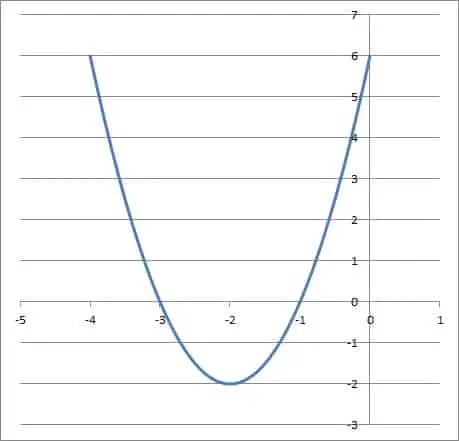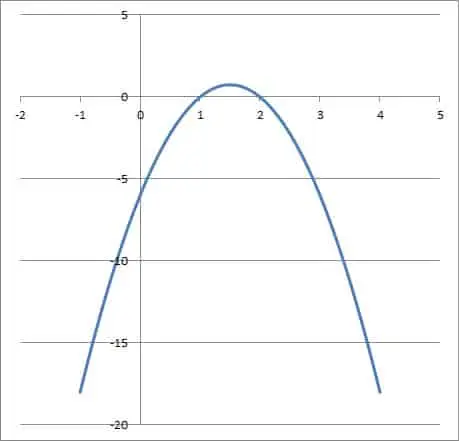The vertex of a parabola is an extreme value of the function. However, it helps to know when it is a maximum or minimum and when it might touch a coordinate axis.
So, what do you need to know about the vertex of a parabola? A parabola’s vertex is the minimum value when a > 0, and in this case, the parabola is convex (concave up) and opens upward (like a cup shape). A parabola’s vertex is the maximum value when a < 0, and in this case, the parabola is concave (concave down) and opens downward (like a dome shape).
Of course, the vertex of a parabola can like on the x-axis, on the y-axis, and in some cases on both at the same time (that is, the vertex is at the origin).
In this article, we’ll answer some common questions about the vertex of a parabola and give some examples to make the concepts clear.
Let’s get started.
Questions About The Vertex Of A Parabola
You might be familiar with what a parabola looks like, but you may still need to know when the vertex is a maximum or minimum and when it touches the x or y axes.
Let’s start with when a vertex is a maximum or minimum
Is The Vertex A Minimum Or Maximum?
The vertex of a parabola can be a maximum or minimum depending on the sign of the leading (quadratic) coefficient, which tells us the shape of the graph of a quadratic.
Here is how to tell if the vertex is a maximum or minimum of a parabola:
- Look at the leading coefficient (that is, the coefficient of the x2 term in the quadratic equation that the parabola comes from).
- Look at the concavity of the parabola (that is, examine the sign of the second derivative, f’’(x), of the quadratic function, f(x), that the parabola comes from).
- Look at the graph of the parabola (which way does it open: up or down?)
Let’s take a look at when each case occurs.
When Is The Vertex Of A Parabola The Minimum Point?
The vertex of a parabola is the minimum point when:
- The leading coefficient is positive (that is, in the quadratic equation y = ax2 + bx + c, we have a > 0).
- The parabola is convex, or concave up (that is, f’’(x) > 0, where f’’(x) is the second derivative of the quadratic function f(x) that the parabola comes from).
- The parabola opens upward (that is, the graph of the parabola is shaped like a cup, not a dome – it would hold water).
Example: The Vertex Of A Parabola Is The Minimum Point
Consider the quadratic function
- f(x) = 2x2 + 8x + 6
As you can see, the leading coefficient (of the x2 term) is a = 2. Since 2 is positive (a > 0), we know that the vertex of the corresponding parabola is a minimum value.
We can also find the second derivative of the function:
- f’(x) = 4x + 8 [first derivative of f(x)]
- f’’(x) = 4 [second derivative of f(x)]
Since 4 is positive (f’’(x) > 0), we know that the function is convex (concave up). This confirms that the vertex of the parabola is a minimum.
Finally, we can also visually confirm that the vertex is a minimum by examining the graph of the parabola below:

When Is The Vertex Of A Parabola The Maximum Point?
The vertex of a parabola is the maximum point when:
- The leading coefficient is negative (that is, in the quadratic equation y = ax2 + bx + c, we have a < 0).
- The parabola is concave, or concave down (that is, f’’(x) < 0, where f’’(x) is the second derivative of the quadratic function f(x) that the parabola comes from).
- The parabola opens downward (that is, the graph of the parabola is shaped like a dome, not a cup – water would run off the top).
Example: The Vertex Of A Parabola Is The Maximum Point
Consider the quadratic function
- f(x) = -3x2 + 9x – 6
As you can see, the leading coefficient (of the x2 term) is a = -3. Since -3 is negative (a < 0), we know that the vertex of the corresponding parabola is a maximum value.
We can also find the second derivative of the function:
- f’(x) = -6x + 9 [first derivative of f(x)]
- f’’(x) = -6 [second derivative of f(x)]
Since -6 is negative (f’’(x) < 0), we know that the function is concave (concave down). This confirms that the vertex of the parabola is a maximum.
Finally, we can also visually confirm that the vertex is a maximum by examining the graph of the parabola below:

Can The Vertex Be The X-Intercept?
The vertex can be the x-intercept of a parabola in some cases (this happens when the vertex rests on the x-axis). We can find out when this will occur by combining what we know about the x-intercept, vertex, and solutions of a quadratic function.
First, remember that the standard form of a quadratic function is given by:
- f(x) = ax2 + bx + c
or
- y = ax2 + bx + c
where a is not zero.
Also, remember that a vertex is unique – a parabola has only one vertex. In this case, the vertex has a y-coordinate of zero, since it rests on the x-axis.
So, the corresponding quadratic equation y = ax2 + bx + c has one solution for y = 0. This occurs when the discriminant is zero, or when b2 – 4ac = 0.
(You can learn more about when a quadratic has exactly one real solution in my article here).
So, if the quadratic equation has b2 – 4ac = 0 (or b2 = 4ac), the corresponding parabola has its vertex on the x-axis (that is, the vertex is also the x-intercept).
Example: The Vertex Is The X-Intercept
Consider the quadratic function
- y = 3x2 + 18x + 27
We have a = 3, b = 18, and c = 27, which means:
- b2 – 4ac
- =182 – 4(3)(27)
- =324 – 324
- =0
Since the discriminant is zero, the corresponding parabola will have its vertex on the x-axis, as you can see in the graph below.

Can The Vertex & Y-Intercept Be The Same?
The vertex can be the y-intercept of a parabola in some cases (this happens when the vertex rests on the y-axis). We can find out when this will occur by combining what we know about the x-intercept, vertex, and solutions of a quadratic function.
First, remember that the standard form of a quadratic function is given by:
- f(x) = ax2 + bx + c
or
- y = ax2 + bx + c
where a is not zero.
The y-intercept occurs where x = 0. This gives us
- y = ax2 + bx + c
- y = a(0)2 + b(0) + c
- y = c
In this case, the y-intercept is given by the point (x, y) = (0, c).
Recall that the vertex form of a parabola is given by
- y = a(x – h)2 + k
where a is as above and (h, k) is the vertex.
If we plug in (0, c) = (h, k) for the vertex (so h = 0 and k = c), we get:
- y = a(x – h)2 + k
- y = a(x – 0)2 + c
- y = ax2 + c
This suggests that the quadratic function must have a linear coefficient of zero, or b = 0.
So, if the quadratic equation has b = 0, then the corresponding parabola has its vertex on the y-axis (that is, the vertex is also the y-intercept).
Note that if we want the vertex to be at the origin (the intersection of the x-axis and y-axis), we need both:
- b2 = 4ac
- b = 0
Taking both equations together implies
- 02 = 4ac
- 0 = 4ac
Since a is not zero, this implies c = 0. So, a quadratic must have b = 0 and c = 0 to have its vertex at the origin.
That is, only a quadratic of the form y = ax2 can have its vertex at the origin (a can be any nonzero value).
Example: The Vertex Is The Y-Intercept
Consider the quadratic function
- y = 2x2 + 8
We have a = 2, b = 0, and c = 8. Since b = 0, the corresponding parabola will have its vertex on the y-axis, as you can see in the graph below.

Is The Vertex Of A Parabola Differentiable?
The vertex of a parabola is differentiable. Since a parabola comes from a quadratic equation (a polynomial of degree 2), we can differentiate as many times as we want and still get a differentiable function.
Note that for any parabola, the corresponding quadratic function has the form:
- f(x) = ax2 + bx + c
The derivative of this function is given by:
- f’(x) = 2ax + b
The vertex of a parabola is at the point when x = -b / 2a, which gives us:
- f’(-b / 2a)
- =2a(-b / 2a) + b
- =-b + b
- =0
Meaning the derivative of the quadratic function is zero (the tangent line is flat, with a slope of zero) at the vertex.
Conclusion
Now you know the answers to a few important questions about the vertex of a parabola. You also have some examples to help illustrate some of these ideas.
You can learn about how to change the shape of a parabola in my article here and the axis of symmetry of a parabola in my article here.
You can learn about the focus of a parabola and what it means here.
You can learn how to find the domain and range of a parabola here.
I hope you found this article helpful. If so, please share it with someone who can use the information.
Don’t forget to subscribe to my YouTube channel & get updates on new math videos!
~Jonathon


